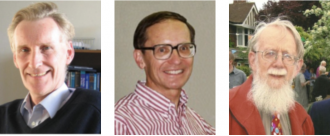| ← prev Side-stepping ‘futility’: Tim Palmer on energy-momentum in general relativity |
Contents |
next → The tropics and tropical-extratropical interactions |

Peter Haynes
Department of Applied Mathematics and Theoretical Physics, University of Cambridge, UK
The papers written by Tim and Michael McIntyre in the 1980s (McIntyre and Palmer 1983, 1984) were met with great interest, and some controversy, and have had a lasting influence on the science of the stratosphere. I began a PhD in 1980 supervised by Michael, so was able to observe the development of some of the ideas that went into these papers as well as some of the subsequent discussion.
Tim’s research on the stratosphere began when he joined the UK Meteorological Office in the late 1970s. The Met Office had invested considerable resources in the Stratospheric Sounding Unit (SSU), a satellite instrument measuring stratospheric temperatures, and was anxious to exploit the potential of these measurements. The first SSU was carried on board the Tiros-N satellite launched in October 1978.
The late 1970s and early 1980s were a very interesting time for stratospheric science. Not only were new observations becoming available but there had recently been important theoretical advances in understanding the dynamics. A snapshot of the state of knowledge and the ongoing activity in the late 1970s is given by a 1980 volume of Philosophical Transactions of the Royal Society, edited by John Houghton, containing papers presented at a Royal Society Discussion Meeting in December 1978, organised to mark the beginning of the international Middle Atmosphere Programme. It was at that time already realized by dynamicists that important aspects of the stratospheric circulation, including the phenomenon of sudden stratospheric warmings (SSWs), could be explained only by taking into account the systematic effect of waves on the zonal-mean flow. Jim Holton (Holton, 1980) surveyed recent work on this topic, focusing on important work by David Andrews and Michael McIntyre which demonstrated that waves could give rise to a zonal-mean force only if they were either transient or dissipating (a ‘non-acceleration theorem’).
He distinguished between extratropical planetary waves (Rossby waves) and equatorial waves and discussed equatorial waves, their dissipation and the resulting forcing of the quasi-biennial oscillation in some detail but gave much less detail on Rossby waves. It seems fair to say that, at this time, a clear physical picture of the dissipation of extratropical Rossby waves was lacking.

In the 1979-1982 period there were several important studies of the dynamics of SSWs, exploiting the new observations and new modelling capability and, in particular making use of E-P fluxes advanced by Andrews and McIntyre as quantifiers of the propagation and dissipation of waves and of their effect on the mean flow. Tim had several discussions with Michael during this period and contributed himself to this work (e.g. Palmer 1981). In his paper ‘How well do we understand the dynamics of sudden stratospheric warmings’ (McIntyre, 1982), Michael drew on these studies and also on theoretical ideas from geophysical fluid dynamics, many based on consideration of the potential vorticity (PV) field. But he remarked on the ‘near impossibility of drawing... maps of potential vorticity from even the best data analyses and thus seeing directly what is going on’. Tim was stimulated by this statement, or perhaps by other interactions with Michael, to attempt to construct PV maps from the data available to him at the Met Office. These maps formed the basis of McIntyre and Palmer (1983) (featured on the front cover of Nature) and (1984).
In these papers Michael and Tim argued that the PV field could be used to distinguish a main vortex structure and a neighbouring or surrounding region in which tongues of low and high PV were being stirred by the large scale flow. This latter process was interpreted as the dissipation or ‘breaking’ of Rossby waves and the region as a stratospheric ‘surf zone’.
Some scientists were initially sceptical that the term wave breaking could be applied to what was seen in the McIntyre and Palmer PV maps, perhaps finding it difficult to see the connection to more familiar examples of the breaking of surface or internal gravity waves. But over time the validity and value of this terminology has become accepted and, furthermore, the vortex/surf zone structure has become a standard part of the interpretation of observations of chemical species and of discussion of dynamics and transport.

| ← prev Side-stepping ‘futility’: Tim Palmer on energy-momentum in general relativity |
↑ top | next → The tropics and tropical-extratropical interactions |
